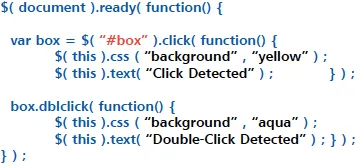
- English
- ePUB (mobile friendly)
- Available on iOS & Android
jQuery in easy steps
About this book
jQuery in Easy Steps begins by explaining how to incorporate the free jQuery library so readers can quickly create interactive web page features by copying the book's examples. It demonstrates how to easily select elements of the web page for manipulation and how to simply produce dynamic responses to user events. Examples illustrate various exciting animation effects and how to employ the power of AJAX to load external data without refreshing the entire web page. The book concludes by demonstrating how readers can use their acquired knowledge to create their very own distributable plugins for the jQuery library. jQuery in Easy Steps assumes readers will already have some basic knowledge of HTML, CSS, and JavaScript and are now ready to embrace the jQuery philosophy of "write less - do more" to enhance their web pages. It has an easy-to-follow style that will appeal to web developers who want to quickly learn the latest dynamic techniques, and to the student who is studying website design at school or college, and to those seeking a career in web development that need a thorough understanding of jQuery.
Frequently asked questions
- Essential is ideal for learners and professionals who enjoy exploring a wide range of subjects. Access the Essential Library with 800,000+ trusted titles and best-sellers across business, personal growth, and the humanities. Includes unlimited reading time and Standard Read Aloud voice.
- Complete: Perfect for advanced learners and researchers needing full, unrestricted access. Unlock 1.4M+ books across hundreds of subjects, including academic and specialized titles. The Complete Plan also includes advanced features like Premium Read Aloud and Research Assistant.
Please note we cannot support devices running on iOS 13 and Android 7 or earlier. Learn more about using the app.
Information











Table of contents
- Getting started
- Performing actions
- Managing forms
- Manipulating elements
- Recognizing events
- Attaching handles
- Producing effects
- Employing AJAX
- Using plugins
- Handy reference